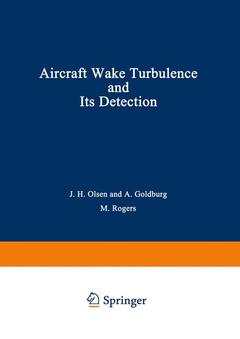Description
Aircraft Wake Turbulence and Its Detection, Softcover reprint of the original 1st ed. 1971
Proceedings of a Symposium on Aircraft Wake Turbulence held in Seattle, Washington, September 1-3, 1970. Sponsored jointly by the Flight Sciences Laboratory, Boeing Scientific Research Laboratories and the Air Force Office of Scientific Research
Coordinator: Olsen John
Language: English
Subject for Aircraft Wake Turbulence and Its Detection:
Keywords
air traffic; control; control system; detection; development; future; information; planning; radar; research; rolling; stability; structure; traffic; turbulence
Publication date: 05-2012
602 p. · 17.8x25.4 cm · Paperback
602 p. · 17.8x25.4 cm · Paperback
Description
/li>Contents
/li>
The combination of increasing airport congestion and the ad vent of large transports has caused increased interest in aircraft wake turbulence. A quantitative understanding of the interaction between an aircraft and the vortex wake of a preceding aircraft is necessary for planning future high density air traffic patterns and control systems. The nature of the interaction depends on both the characteristics of the following aircraft and the characteristics of the wake. Some of the questions to be answered are: What deter mines the full characteristics of the vortex wake? What properties of the following aircraft are important? What is the role of pilot response? How are the wake characteristics related to the genera ting aircraft parameters? How does the wake disintegrate and where? Many of these questions were addressed at this first Aircraft Wake Turbulence Symposium sponsored by the Air Force Office of Sci entific Research and The Boeing Company. Workers engaged in aero dynamic research, airport operations, and instrument development came from several count ries to present their results and exchange information. The new results from the meeting provide a current picture of the state of the knowledge on vortex wakes and their interactions with other aircraft. Phenomena previously regarded as mere curiosities have emerged as important tools for understanding or controlling vortex wakes. The new types of instability occurring within the wake may one day be used for promoting early dis integration of the hazardous twin vortex structure.
Keynote Address.- Aircraft Wakes: A New Look at a Classical Problem.- Fundamental Problems.- The Velocity of Viscous Vortex Rings.- Studies in the Motion and Decay of Vortices.- Transport of a Vortex Wake in a Stably Stratified Atmosphere.- Experimental Methods.- Split-Film Anemometer Sensors for Three-Dimensional Velocity-Vector Measurement.- Sub-Scale Modeling of Aircraft Trailing Vortices.- The Utility of Doppler Radar in the Study of Aircraft Wing-Tip Vortices.- Application of Laser Doppler Systems to Vortex Measurement and Detection.- Wake Formation and Character.- An Analysis of Flight Measurements in the Wake of a Jet Transport Aircraft.- Vortex Control.- The Effect of a Drooped Wing Tip on Its Trailing Vortex System.- Some Work at the Royal Aircraft Establishment on the Behaviour of Vortex Wakes.- Span Loading and Formation of Wake.- An Experimental Investigation of Trailing Vortices Behind a Wing with a Vortex Dissipator.- Vortex Wake Development and Aircraft Dynamics.- Measurements of Boeing 747, Lockheed C5A and Other Aircraft Vortex Wake Characteristics by Tower Fly-by Technique.- Flight Evaluation of the Wing Vortex Wake Generated by Large Jet Transports.- Stability and Decay.- An Assessment of Dominant Mechanisms in Vortex-Wake Decay.- Theoretical and Experimental Study of the Stability of a Vortex Pair.- Structure of a Line Vortex in an Imposed Strain.- A New Look at the Dynamics of Vortices with Finite Cores.- Decay of an Isolated Vortex.- Decay of a Vortex Pair Behind an Aircraft.- Results of Trailing Vortex Studies in a Towing Tank.- Interactions with Vortex Wakes.- Results of the Boeing Company Wake Turbulence Test Program.- Aircraft Response to Turbulence Including Wakes.- Airloads and Moments on an Aircraft Flying Over a Pair of Inclined Trailing Vortices.- Aircraft Wake Turbulence Controllability Experiment.- Fog Formation and Dispersal by Trailing Vortices.- An Estimate of the Power Required to Eliminate Trailing Vortices by Suction.- Panel Discussion.- Conclusions.- Author Index.
© 2024 LAVOISIER S.A.S.

